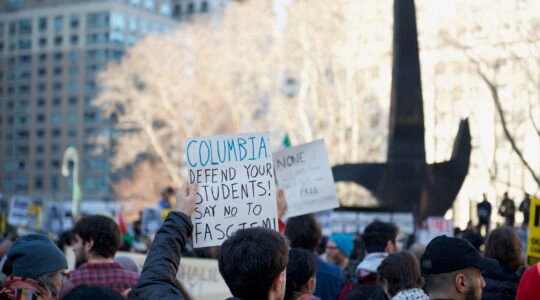Was it empathetic or offensive for a leading German official to recommend that Jews not wear kipas in public under certain conditions?
In an interview last Friday, Felix Klein, Germany’s commissioner on anti-Semitism, said his views on the issue have changed because of the increasing concern about anti-Semitic incidents. There were about 1,800 reported crimes of that nature in 2018, an increase of 20 percent. “I can’t recommend that Jews wear a kipa every and any time,” he said. “Sad to say.”
Josh Spinner, the CEO of the Ronald Lauder Foundation office in Berlin, told JTA that Klein’s remarks come “from a very, very strong place of honesty,” and noted that “in the next sentence” the German official said public servants need to be better educated in combating anti-Semitism.
But Rabbi Yehuda Teichtal, who heads a Chabad Lubavitch center in Berlin, said, “Klein’s intentions are good, but we know that hiding our identity was never the solution.”
Israeli President Reuven Rivlin went further, expressing shock at Klein’s comments. He said that despite appreciation for “the moral position” of the German government and “its commitment to the Jewish community,” the “fears about the security of German Jews are a capitulation to anti-Semitism and an admittance that, again, Jews are not safe on German soil.” The president added: “We will never submit, will never lower our gaze and will never react to anti-Semitism with defeatism — and expect and demand our allies act in the same way.”
In response to the controversy, Germany’s most popular tabloid, BILD, published a cut-out of a kipa and encouraged readers to wear it as a show of solidarity with the German Jewish community.
The dramatic rise in visible forms of anti-Semitism in Europe of late has been dealt with in a variety of ways, including significant media coverage and strong statements opposing this form of racism, and participation in rallies by national leaders in France, Germany and other countries.
Results of the European Union elections this week were mixed, with widening divisions and more support for upstarts, signaling dissatisfaction with establishment parties.
Closer to home, it’s worth noting that The New York Times published its second editorial in a month on the rise of anti-Semitism (May 26), pointedly asserting that it is coming from the far left as well as the far right. Critics have said the paper tends to highlight bias from the right far more than from the left. Perhaps the outcry over The Times’ European edition’s recent publication of a cartoon widely condemned as anti-Semitic has registered sufficiently with top editors to have them reassess their analysis of the severity and causes of this ancient curse. Finally.
The New York Jewish Week brings you the stories behind the headlines, keeping you connected to Jewish life in New York. Help sustain the reporting you trust by donating today.




